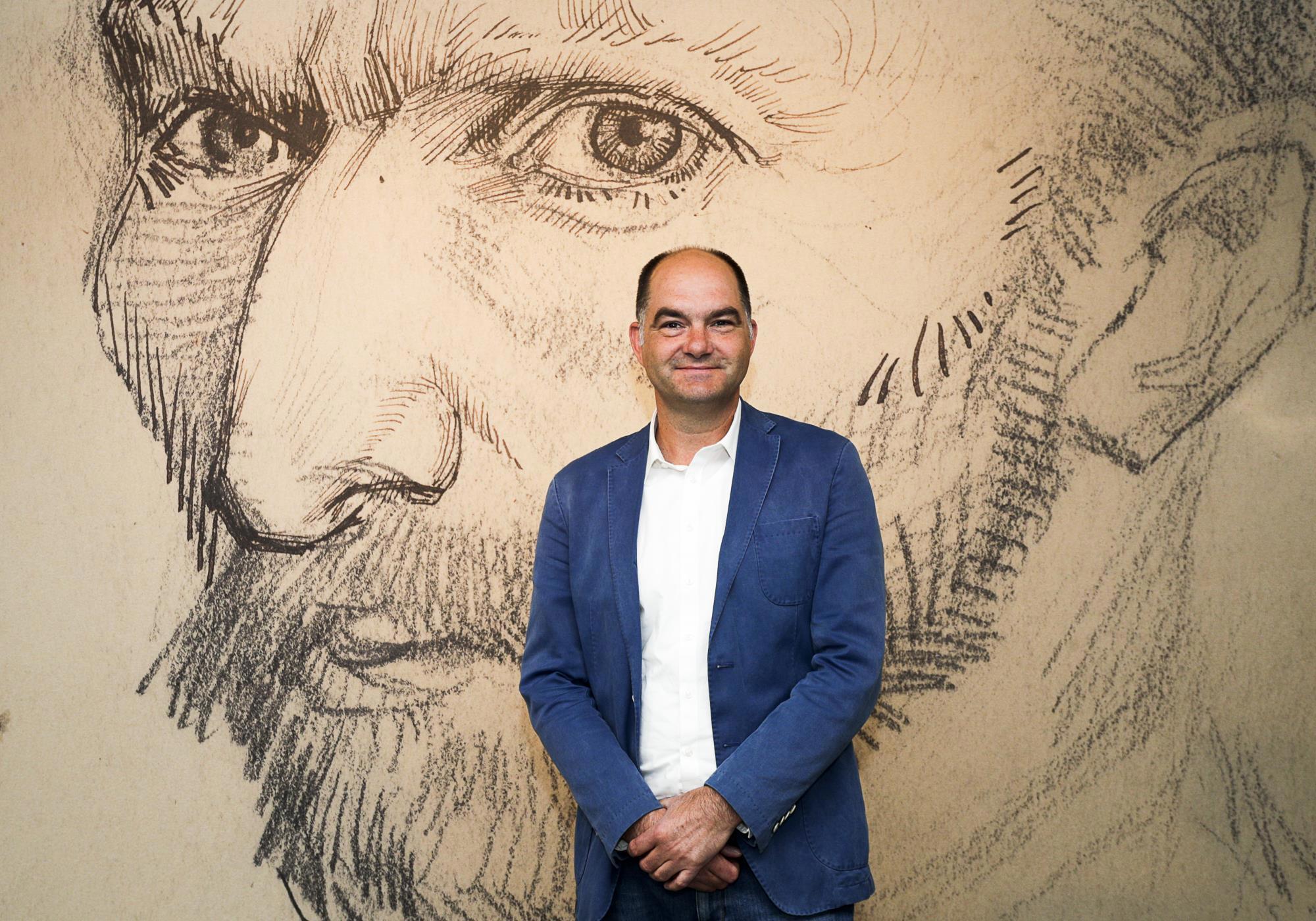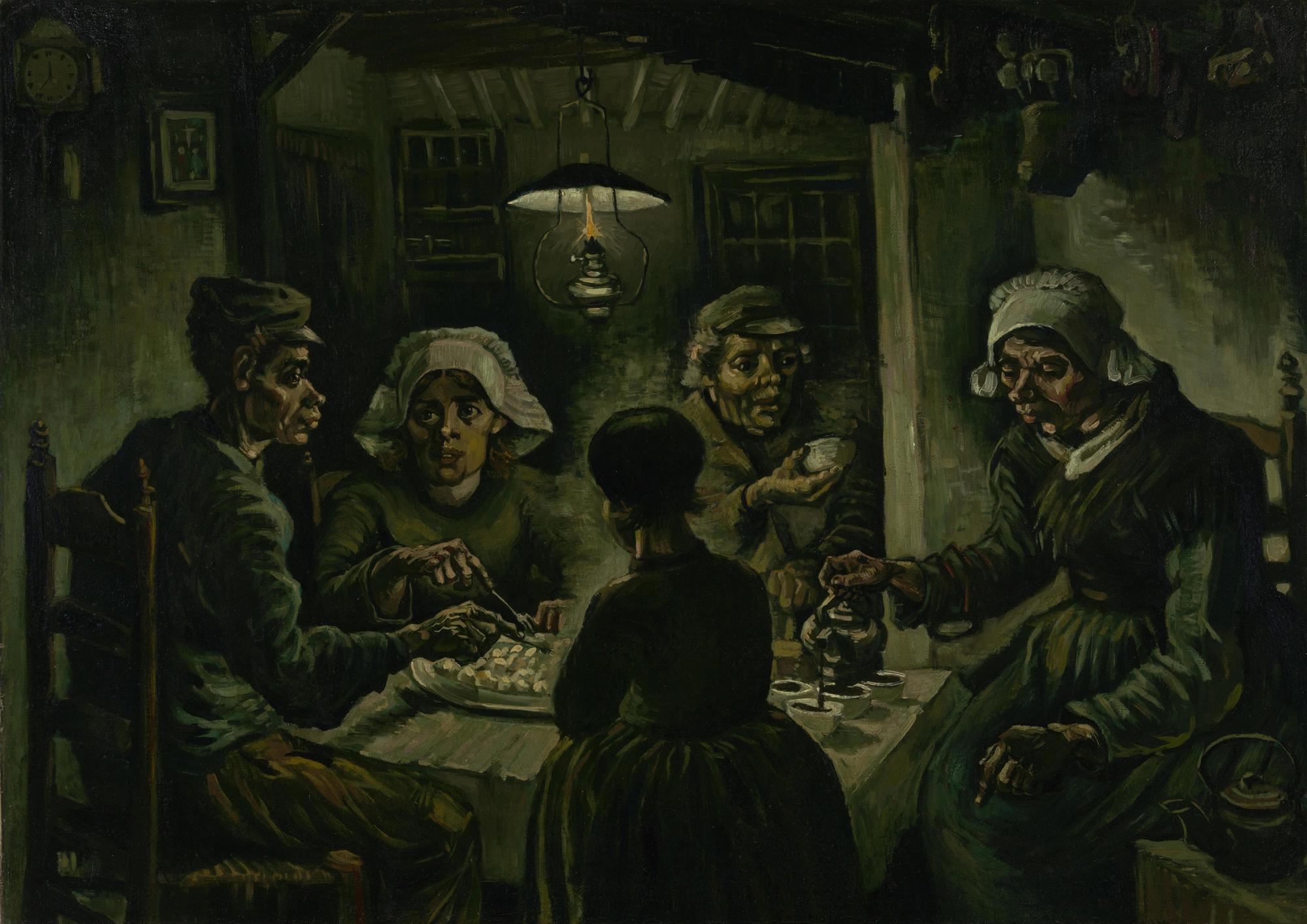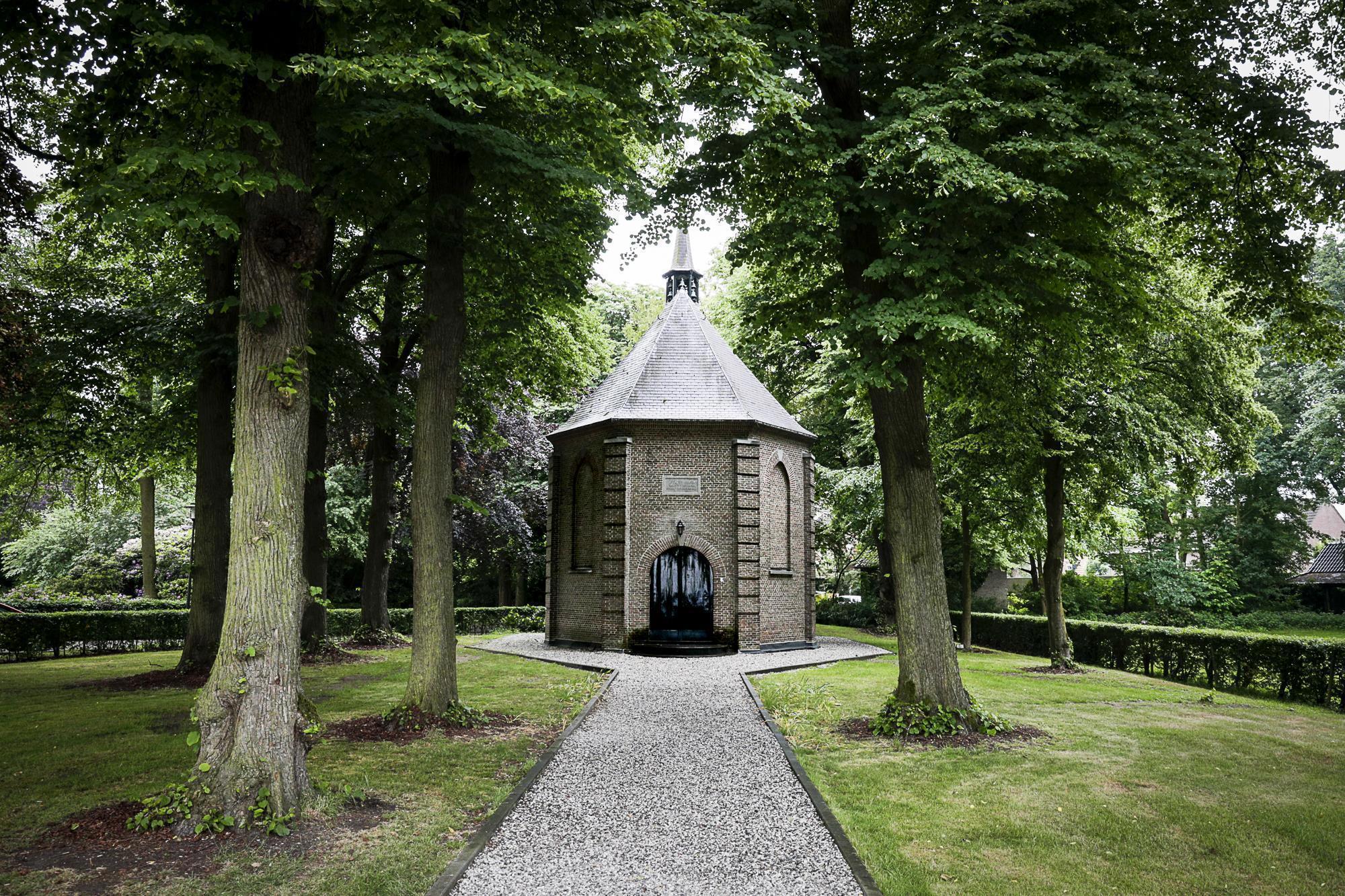Vincent van Gogh and Brabant are inextricably linked. Frank van den Eijnden, the man behind Van Gogh Brabant, talks about his fascination for Van Gogh.
Vincent van Gogh and Brabant are inextricably linked. The little boy from Zundert grew up to become a world-famous artist who would leave his mark on the world. Today, 165 years after his birth, Van Gogh is still an unfading source of inspiration for artists, designers and entrepreneurs. Certainly also for Frank van den Eijnden, the man behind the Van Gogh Brabant and Van Gogh Europe associations. “Van Gogh the artist has had a special place in my heart ever since I was a boy.”
As a young man, Van den Eijnden played at club level in a basketball team in Beek en Donk. The players from a club from Prague wanted to visit Nuenen when they came to the Netherlands to play against his team. The artist lived and worked there from 1883 to 1885. “I had no idea”, Van den Eijnden says. “Van Gogh had lived a stone’s throw away from our village, and I didn’t know about it. It turned out that I wasn’t alone.”

Vincent, the son of a parson, was born in Zundert on 30 March 1853. He grew up in the protected environment of the village parsonage. He is different: a Protestant child in a predominantly Catholic community, who does not go to school and is educated at home. The Vincent van Gogh Huis now stands on the site of his former home. The digital audio and visual presentation transports you into the Van Goghs’ living room where you discover his passions and interests. You can also visit the garden where Vincent played as a child. The church where his father preached, and where his older brother and namesake is buried, is just around the corner.
Today, Nuenen is a true open-air museum dedicated to Van Gogh. Starting from the Vincentre Museum, you can walk or cycle a route that takes you to 21 buildings, objects and places in the landscape that Van Gogh painted. You walk - or cycle - in the footsteps of the great master as you follow this special Van Gogh Roosegaarde cycling route. In the centre itself, you can experience how Vincent lived and worked in Nuenen. The stories about him, the letters he wrote and his paintings are all on display here. Audiovisual techniques transport you back to the era in which Vincent van Gogh lived.
This is one of the places that has helped Van den Eijnden put Van Gogh and Brabant on the map internationally. “During the Van Gogh year in 2015, Nuenen town council had to install Dixi toilets for all those buses full of American and Japanese tourists.”
The theme year was a great success, as national statistics show: 1.7 million visitors in total, with one million from foreign countries. On average, they spent €505 during a stay that lasted a minimum of two days. In total, the Van Gogh year generated a revenue of about €500 million. The collaborating parties associated with Van Gogh took advantage of this success and set even higher targets for themselves. The Van Gogh Heritage Centres in Nuenen, Etten-Leur and Zundert are now building new museum presentations. These improvements, in conjunction with the Van Gogh exhibition in Het Noordbrabants Museum in 2019, are expected to lead to a further increase in the number of people visiting Brabant.
A further ambition is to secure the European Cultural Heritage Label together with Van Gogh Europe. This initiative of the European Union is designed to promote cultural heritage that is considered to have played a prominent role in establishing the Europe of today. Successfully obtaining that label will help Brabant benefit from a strong increase in the number of international visitors to the Netherlands.
At the age of 13, Vincent is sent to boarding school at the Rijks-HBS school in Tilburg, located in the former palace of King Willem II. This was where he attends his first art classes from September 1866 to March 1868. His produces his first drawing here, which depicts two farmers leaning on a shovel. Today, you can visit Vincents Tekenlokaal (Vincent's Art Room) in the very building where he went to school. The classroom is exactly as it was in Van Gogh's time and you can experience how the young boy received his first serious art lessons from his teacher, Constant Huijsmans.
Three years after the Van Gogh year, Van den Eijnden – as the programme manager for VisitBrabant, director of Van Gogh Brabant and chairman of Van Gogh Europe – still looks at things from a Van Gogh perspective. “When I participate in an activity, I give it my full commitment. As a true son of Brabant, the region of Brabant shapes my mission.”
And what is that mission? “To pass on our Van Gogh heritage to future generations and encourage more international visitors to stay longer in Brabant. We have succeeded in having 39 buildings and locations nominated as Van Gogh Monuments. We also want to apply this approach in Belgium and France via Van Gogh Europe. And in London, because Van Gogh spent some time there as well. The owner of the property where the painter stayed has plans for an artist in residence.”

After spending time in London and Paris and attempting to become an art dealer, teacher and preacher, Vincent (who is now 28) moves back in with his parents for a period of six months in March 1881. They have moved house and are now living in the parsonage in Etten. This is a turning point in his life. Vincent starts to apply himself more to his drawings, working day and night. A number of dramatic events make him realise that he has always allowed himself to be influenced by others when making his choices. He more or less renounces his faith and decides to pursue his dream of becoming an artist. It is in Etten that he has himself registered as a painter for the first time.
According to Van den Eijnden, Van Gogh Europe is a network of organisations that strive to share knowledge and jointly focus attention on the work and life of Vincent van Gogh in Europe, Asia and America. “Sustainable collaboration at European level ensures a lively interest in Van Gogh's heritage”, he says. “In Brabant, we now have five locations that are of interest to Van Gogh fans: the Vincent van Gogh Huis in Zundert, Vincents Tekenlokaal (Vincent's Art Room) in Tilburg, the Van Gogh Kerk (Van Gogh Church) in Etten-Leur, the Vincentre Museum in Nuenen and Het Noordbrabants Museum in ’s-Hertogenbosch. The more visitors that come to these locations, the better it is for Brabant and for guaranteeing the financial support required for preserving cultural facilities.”
Furthermore, Het Noordbrabants Museum in ’s-Hertogenbosch is the only location in the south of the Netherlands where Van Gogh originals adorn the walls. The twelve paintings include ‘Digging farmer’s wife’, ‘Still life with bottles and shell’, ‘The parsonage garden in Nuenen’ and ‘The watermill at Kollen’. The latter painting is one of the 39 protected Van Gogh Monuments. Not only are they are important for Brabant's culture, but also for the region´s leisure economy, nature and landscape, branding and international profile.
From December 1883, Vincent – who is now 30 – lives in his parents´ new home town of Nuenen for a period of two years. He concentrates fully on his painting in Nuenen. His sisters interfere in a romantic relationship with a local woman, causing it to end. And his father passes away not long afterwards. In spite of these trials and tribulations, Vincent continues to paint passionately. He produces a quarter of his total oeuvre in Nuenen. Inspired by nature and simple people, his experiments ultimately lead to ‘The Potato Eaters’, his first masterpiece.

Met Van Gogh Brabant en Van Gogh Europe wil Van den Eijnden letterlijk en figuurlijk grenzen verleggen. Net zoals Vincent van Gogh dat deed. “Je ziet nog steeds dat veel Brabantse makers de grens overgaan. Niet alleen omdat kunst geacht wordt grensoverschrijdend te zijn, maar ook omdat het Brabantse podium niet altijd genoeg ruimte biedt. Zo ook onze mondiaal meest geroemde en grensverleggende kunstenaar Vincent van Gogh. Hij ging in de laatste jaren van zijn leven de grens over om te kunnen groeien in zijn kunstenaarschap. Uiteindelijk moeten we in Brabant het klimaat scheppen dat je daarvoor de provincie niet meer hoeft te verlaten.”
Van den Eijnden literally intends to venture far beyond domestic boundaries with Van Gogh Brabant and Van Gogh Europe. Just like Vincent van Gogh. “Many creative people from Brabant still seek their fortune outside the Netherlands. Not just because art is considered to cross all borders, but also because the stage in Brabant is sometimes too constricting. This also applies to Vincent van Gogh, our most famous artist globally speaking and somebody who refused to be constrained by borders. During the last years of his life, he moved abroad in order to grow to full maturity in his artistry. Ultimately, we must create a climate of opportunity in Brabant that keeps creative talent here in the province.”

In 1885, Vincent moves to Antwerp to attend the Art Academy. After less than six months, he continues on to Paris, where his brother Theo lives. Vincent puts up with the hectic city life of the capital for two years. At the beginning of 1888, he settles in Arles in Provence. With an artists’ colony in mind, he rents four rooms in the ‘yellow house’ overlooking La Place Lamartine. Paul Gauguin is the only artist who comes to live with him. The relationship between the two artists becomes so strained that Vincent cuts off his own left ear one evening and is committed to a mental hospital. He produces some 150 paintings in just one year. In mid-1890, he is discharged from the mental hospital and moves to Auvers-sur-Oise where several other artists already live. His ill-health and (financial) worries about the future ultimately cause him to take his own life. On July 27 1890, he walks into a field of wheat and shoots himself in the chest with a pistol. He succumbs to his injuries two days later. He leaves behind a legacy of 850 paintings and nearly 1300 drawings on paper.
You can copy the full text of this story for free at the touch of a button